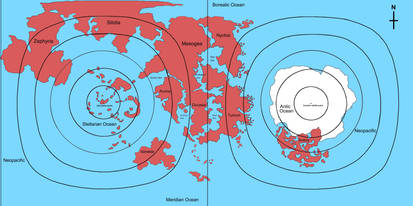Deviation Actions
Description
Mercury was a harsh world, but in its own way, very rich. It was hot enough to melt lead, it rotated too slowly for space elevators*, it was almost entirely without water, its gravity was too heavy for easy takeoffs and too light to hold an atmosphere, however, it held the keys to the greatest treasure in the system: Sol. Mercury offered inexhaustible raw materials and a usable Lagrange point for a great solar collector. This collector, known as Eos Station, would provide energy to the entire solar system, using lasers and mirrors to beam power to distant cities, propel solar sailors, and break the Seleno-American energy monopoly.
Still, settling the planet was no small thing. The low gravity was a barrier, but it was greater than that of Mars, and that had proven survivable. The heat could be dealt with simply by building in the shade and elevating structures off the hot ground with stilts; there was no smothering atmosphere like on Venus after all. The real problem was Mercury's lack of water, nearly all of which had been blown to the outer solar system billions of years ago. The only places with free water were the craters in the polar regions, down where the sun had never shown. The Eos Company enticed a group of fifteen thousand colonists to settle Mercury, half to stay in orbit and build the station, half to source raw materials from the surface.
The Eos company had been chartered through a treaty between the united Republic of Korea and the Kingdom of England. They were small countries that had stubbornly clung to their national sovereignty, and despite punching above their weight in the Second Space Race, they were still marginalized by larger states. The Mercury venture, they hoped, would ensure their power for the long term. For practicality's sake, however, the Eos company was compelled to seek smaller investments from other states, America, Europe, and India primarily. The expedition launched in 2079.
Mercury started exporting power after only a year, and its population and export capacity started to grow. Then it was interrupted as the Othrys Plague came to Earth, and climate change started to cause the old-countries to unravel. Mercury did not suffer very badly when the refugees started pouring out of Earth. It was too small, too hot, too distant. The leaders of Earth at the time could not be bothered with settling a few poultry thousand in a wasteland when there were billions to settle on Luna, Mars, Venus, and the Belt. Eos station, however, drew their attention. The energy that it produced was indispensable. Resettlement was an energy intensive business after all. Though Eos was placed under military occupation after the Martian and Belt revolts, the surface remained untouched.
Mercury escaped massive overpopulation, but new immigrants did continue to come. Aside from the engineers and workers necessary to keep expanding Eos Station, the nervous governments of Earth also sent some of their best and brightest minds of art and science, as well as many of the wealthy and powerful (including princess Charlotte’s son, Henry), not to mention important works of art, historical artifacts, and a complete archive of the internet. Essentially, Mercury would be the system's insurance incase everything went wrong, the life boat of its cultural heritage.
When the war that devastated Earth and Luna began, fierce fighting broke out between different forces of the Eos occupation force for control of the vital power source. When one side gained the upper hand, the other decided that it was too great an advantage to give to the enemy, so they destroyed the station and themselves. Officially, the different colonial settlements were also in a state of war when their parent nations started massacring each other, but seeing the destruction wrought above, as well as that on Earth, Luna, and Venus, the Mercurian surface colonies agreed to unilateral neutrality. The rest of the system barely noticed.
After the dust of the Collapse settled, Mercury stood almost magically untouched by the carnage. Her stock of survivors was small, and their livelihood was destroyed, but of all the bodies in the system, the people of Mercury suffered the least damage. In the years to come, this would prove a blessing and a curse.
*The slower something rotates about its axis the higher its geostationary orbit, thats just the way orbits work, and after a terrifying evening of calculations I discovered that the geostationary orbit on Mercury is so high that a cable would have to go through the sun to be long enough.


































